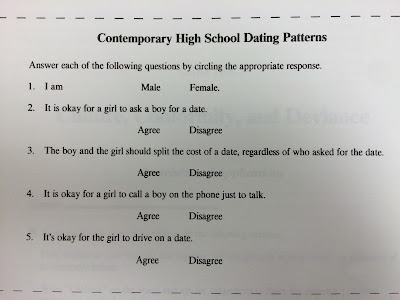2. High School Dating Patterns
3. "They and We" from Rudyard Kipling
4. What is Ethnocentrism and Cultural Relativism?
- Ethnocentrism: the idea that your own group or culture is better or more important than others
- Cultural Relativism: the principle that an individual person's beliefs and activities should be understood by others in terms of that individual's own culture.
In 1997, Annette Sorensen, 30, an actress from
Copenhagen, Denmark, and Exavier Wardlaw, 49, a movie production assistant from
Brooklyn, NY, were arrested for leaving their 14-month-old daughter outside a
Manhattan restaurant on a chilly day while they ate inside the restaurant. They
left the child in her baby carriage on the sidewalk. Many passersby called 911
to alert the police. New York authorities took the child away from her parents
and temporarily placed her in foster care.
In an ensuing article in the New York Times, one
Danish commentator observed that leaving a baby outside of a restaurant is a
very common practice in Denmark. The commentator wrote, “Often, Danish parents.
. . leave their babies outside. For one thing, Danish baby carriages are
enormous. Babies ride high above the world on horse-carriage-size wheels. It’s
hard to get such a carriage into a cafe. . . . Besides, Danish cafes are very
smoky places.” The commentator continued, “In Denmark, people have an almost
religious conviction that fresh air, preferably cold air, is good for children.
All Danish babies nap outside, even in freezing weather—tucked warmly under
their plump goose-down comforters. . . . In Denmark all children own a sort of
polar survival suit that they wear from October to April and they go out every
day, even in winter.”
What would be an ethnocentric
interpretation of the parents’ actions?
What would be a culturally relative
interpretation of the parents’ actions?
5. An Idiot Abroad- India: 2:30-15:30 (13 mins)
Requirements
A. You now need to present what you wrote about your label in some sort of visual, creative way. I am open to different ways to present your work, but it must be a primarily visual medium than can be shared with the class (without you having to present it - it should speak for itself). Keynote and Powerpoint are NOT allowed.
Some suggestions would be:
- Adobe Voice (iPad app)
- Canva (iPad app)
- iMovie (Ipad app)
- Prezi (iPad app)
- Thinglink
- Other applications must be approved by Mr. Parise
C. Grading Rubric
1. The presentation contains all necessary information (A-D), and is accurate - 50 pts
2. The information is presented in an aesthetically pleasing and creative way - 20 pts
3. The presentation is free of grammar and punctuation errors - 10
4. The presentation uses an approved presentation medium - 10
5. The presentation is shared with the class - 10
D. Due - 9/28 - counts as a TEST grade
E. Late Policy - 10 points deducted for each day late, up to one week. After one week, you may not turn in the assignment (you'll get a zero).
Here is the info you need in your project
A. Choose ANY social label. Describe that label. When people use that label to describe someone, what are the unstated assumptions about the person are implied by the use of that label. Does the label carry a positive or negative connotation? Is the label one that a person would give themselves, or that someone would give someone else, or both?
B. Provide an image of what a "typical" person given that label might look like. It can be drawn, found on the web, or photo created by you. You are not allowed to use an photo of another TA student (you must be the subject of a photo).
C. Ask 5 people (only one may be a close friend, and no one from a sociology class) to describe what they think of when asked to imagine a person who is given the label you are investigating. Record their answers.
D. Analyze the possible social advantages or disadvantages of being given this label. Is it more likely to positively or negatively impact a person's life, self-esteem, or social status?

No comments:
Post a Comment